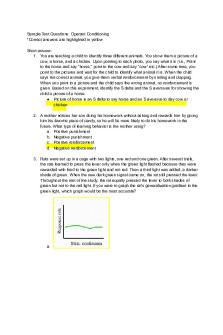Psych Test Questions (Ch: Operant Conditioning) PDF

| Title | Psych Test Questions (Ch: Operant Conditioning) |
|---|---|
| Course | Learning Theory |
| Institution | University of North Florida |
| Pages | 2 |
| File Size | 111.8 KB |
| File Type | |
| Total Downloads | 70 |
| Total Views | 155 |
Summary
Sample test questions for practice...
Description
Sample Test Questions: Operant Conditioning *Correct answers are highlighted in yellow Short answer: 1. You are teaching a child to identify three different animals. You show them a picture of a cow, a horse, and a chicken. Upon pointing to each photo, you say what it is (i.e., Point to the horse and say “horse,” point to the cow and say “cow” etc.) After some time, you point to the pictures and wait for the child to identify what animal it is. When the child says the correct animal, you give them verbal reinforcement by smiling and clapping. When you point to a picture and the child says the wrong animal, no reinforcement is given. Based on this experiment, identify the S delta and the S aversives for showing the child a picture of a horse. ● Picture of horse is an S delta to say horse and an S aversive to day cow or chicken 2. A mother notices her son doing his homework without asking and rewards him by giving him his favorite piece of candy, so he will be more likely to do his homework in the future. What type of learning behavior is the mother using? a. Positive punishment b. Negative punishment c. Positive reinforcement d. Negative reinforcement 3. Rats were set up in a cage with two lights, one red and one green. After several trials, the rats learned to press the lever only when the green light flashed because they were rewarded with food to the green light and not red. Then a third light was added, a darker shade of green. When the new dark green signal came on, the rat still pressed the lever. Throughout the rest of the study, the rat equally pressed the lever to both shades of green but not to the red light. If you were to graph the rat's generalization gradient to the green light, which graph would be the most accurate?
a.
b.
c. d. None of the above...
Similar Free PDFs

Operant conditioning pdf
- 2 Pages

Operant conditioning in cats
- 5 Pages

makalah operant conditioning
- 12 Pages

Forum 4-operant conditioning
- 1 Pages

Operant conditioning The basics
- 5 Pages
Popular Institutions
- Tinajero National High School - Annex
- Politeknik Caltex Riau
- Yokohama City University
- SGT University
- University of Al-Qadisiyah
- Divine Word College of Vigan
- Techniek College Rotterdam
- Universidade de Santiago
- Universiti Teknologi MARA Cawangan Johor Kampus Pasir Gudang
- Poltekkes Kemenkes Yogyakarta
- Baguio City National High School
- Colegio san marcos
- preparatoria uno
- Centro de Bachillerato Tecnológico Industrial y de Servicios No. 107
- Dalian Maritime University
- Quang Trung Secondary School
- Colegio Tecnológico en Informática
- Corporación Regional de Educación Superior
- Grupo CEDVA
- Dar Al Uloom University
- Centro de Estudios Preuniversitarios de la Universidad Nacional de Ingeniería
- 上智大学
- Aakash International School, Nuna Majara
- San Felipe Neri Catholic School
- Kang Chiao International School - New Taipei City
- Misamis Occidental National High School
- Institución Educativa Escuela Normal Juan Ladrilleros
- Kolehiyo ng Pantukan
- Batanes State College
- Instituto Continental
- Sekolah Menengah Kejuruan Kesehatan Kaltara (Tarakan)
- Colegio de La Inmaculada Concepcion - Cebu










